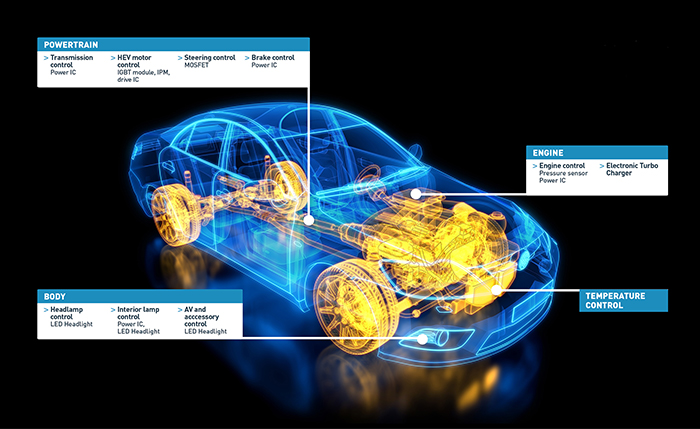 Minimizing CTE via insulated metal substrates.
Minimizing CTE via insulated metal substrates.
Today’s automotive industry is going through a period of rapid and significant technical change. People get so much from their cars – mobility, freedom of expression, social opportunities, pure excitement – and will not give up these privileges and pleasures easily. So carmakers are rapidly adopting electronic technologies to overcome valid social concerns, such as environment and safety, while at the same time intensifying the benefits for their customers.
On the other hand, large automotive corporations are historically renowned for their conservative behavior. The huge investment needed to get a new model into showrooms means they cannot risk getting too far ahead of the market. But all this could be changing, as the major manufacturers seek to tempt customers with more advanced electronic gadgetry. They know this is vital, both to meet legislative demands and to satisfy consumers who have become accustomed to fast-moving markets for products like mobiles, tablets and smart-home gear. Huge demands to raise performance and lower price, which are always present in the automotive industry, are sure to force the electronics industry to turn around quickly with new and innovative solutions. We could see significant progress in areas like thermal management, for example.
Good thermal management is vital to ensure reliability. We know that reducing operating temperature by 10°C can double the lifetime of components like ICs and LEDs – the so-called Arrhenius law. Carmakers need to “life” key components and subsystems (not only the electronics but major mechanical elements as well) to uphold their reputation and minimize warranty claims. Keeping chip temperatures low enough to provide the desired assurance regarding lifetime, without over-engineering the thermal solution, is important when designing high-power electronic assemblies like LED headlamp matrices, engine-management computers, electric power-steering (EPS) controllers, or the on-board chargers (OBC) of plug-in hybrid and battery-electric vehicles. And then, of course, hybrid/electrics (H/EV) traction-motor drives take thermal management to an even higher level, calling for techniques like bare-die assembly and liquid cooling.
Cost is a vital part of the equation in automotive electronics. Thermal management introduces additional materials and processes to the manufacturing of the product. Ordinary FR-4 PCB substrates can be thermally enhanced using techniques such as drilling and then filling or plating vias in specific areas, to conduct heat through the board to a spreader or heatsink on the other side, but this is time-consuming and expensive. Other techniques include embedding a metallic thermal slug into the board in areas where dissipation is high. Such areas may be underneath power components or high-speed ADCs, for example. The automotive industry will demand solutions that are much less intricate and easier to produce at low cost in high volumes. Even so, we can expect demands for even higher-performing solutions to grow as well.
Insulated metal substrate (IMS) is a mature technology that still has room to raise performance to meet automotive industry demands. In fact, IMS product lines have already become rather sophisticated. At Ventec, for example, our advanced dielectrics cover a broad spectrum, including ultra-low thermal impedance (ZTH) down to 0.0078°Cin2/W, and special formulas that are optimized for use with copper baseplates. The choice of copper or aluminum alloys in various grades, depending on requirements like machinability or corrosion resistance, permits control over price and the extent to which CTE (coefficient of thermal expansion) mismatches between the circuit foil and baseplate can be minimized. The demands of the automotive industry will drive the emergence of new material formulas, as well as creative blending of properties, sizes and thicknesses, to satisfy increasingly stringent demands on performance and affordability.
While the industry is moving quickly to embrace electronic technologies, many companies are still trying to get the right skills in the right places. Thermal-management specialists are scarce right now in automotive, so materials suppliers must be open to long-term technical collaborations with their customers’ engineers to meet the exacting requirements of each application.
Thermal-management challenges presented by systems such as high-performance LED headlamps, anti-dazzle lighting, miniaturized DRLs and turn signals, electric power steering units, EV traction inverters, and others often require novel solutions.
Next to cost constraints, limitations on size and weight are often also extremely tough. LED lamp units, for example, must typically be extremely small, intricately shaped, and low-profile, as stylists try to achieve dramatic new looks. Circuit boards can be very complex, with many closely-spaced emitters, but at the same time have extremely limited surface area for heat dissipation. There is no real consensus on the best design approaches with these lamps, so while some contain many emitters on a single board, forming a dense matrix, others may feature several boards containing a few emitters each.
In many cases the role of the IMS is to provide a thermally efficient channel for dissipating heat into a metal housing and ultimately to the ambient environment. Engineering a solution involves not only choosing and dimensioning materials with suitable mechanical, thermal and electrical properties, but also creating a suitable shape that can be produced by a repeatable and cost-effective process. To achieve this, routing and bending/folding can produce a 3D electronic assembly ready to be screwed or bonded into position within the housing. Going forward, we can envisage further refinement and simplification of these processes.
Of course, other markets such as LED lighting and smart home appliances – not to mention mobile robotics, renewable energy, and industrial automation – are also pushing hard for smaller, better, and more cost-effective solutions to thermal management. They will keep the pressure on materials suppliers to develop new formulations and new ways of using them.
With the prospects for further dramatic changes in the automotive sector, such as self-driving vehicles that will pack power electronics and high-performance real-time computing into tiny form factors, the formerly cautious and conservative car industry is now one of the most powerful catalysts for change.

Figure 1. While always critical with auto electronics, specific thermal management solutions are being more customized. (Ventec International Group)
Martin Cotton is director OEM technology at Ventec International Group (ventec-group.com); This email address is being protected from spambots. You need JavaScript enabled to view it..














